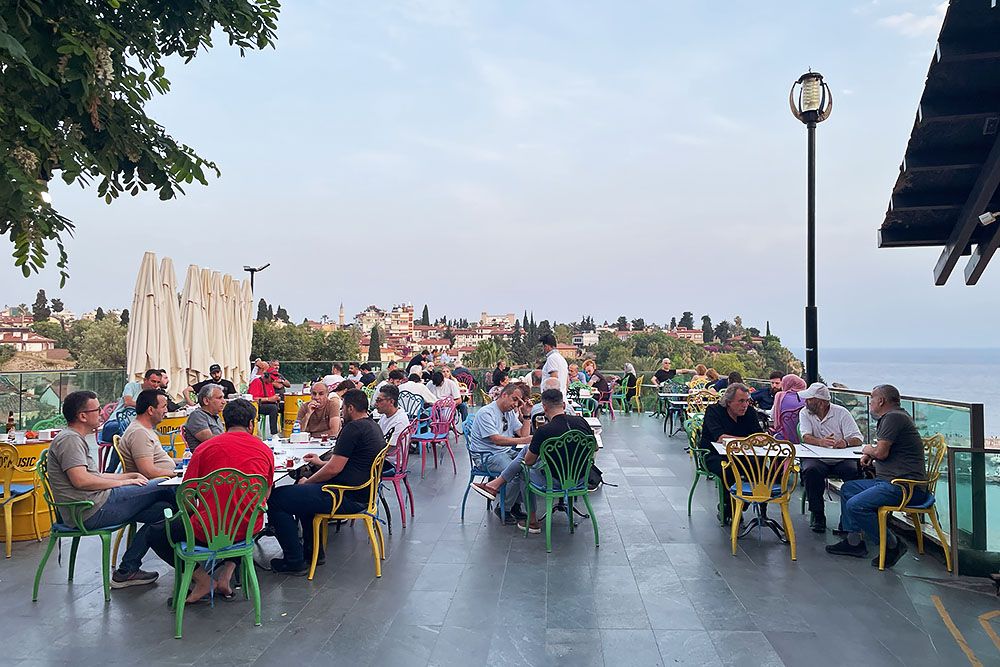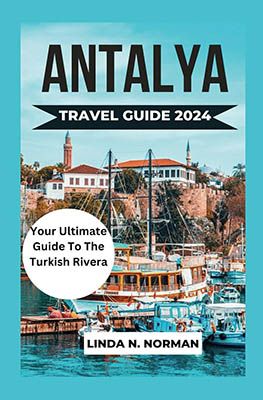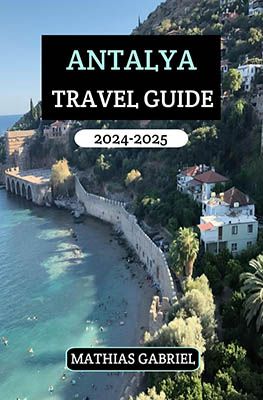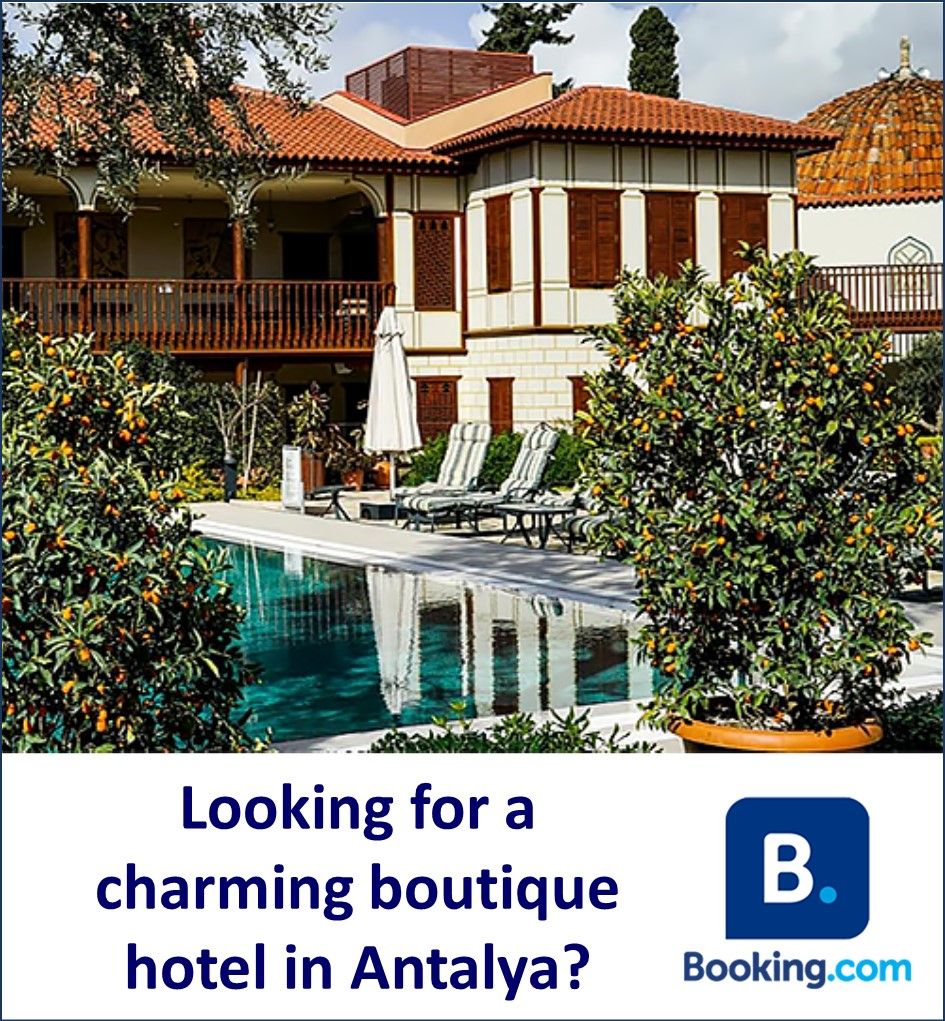In late May, we were on a tour along the southern coast of Türkiye. The starting point of the journey was Antalya, a city we had the image of large all-inclusive beach resorts. Unjustly, as it turned out later. For although there are indeed all-inclusive resorts outside Antalya, there is much more to discover in the city itself. Kaleiçi, the charming old town, offers a mix of historical sights and a vibrant food culture. But there is also plenty to see and experience outside the city limits. The beautiful beaches and turquoise waters of the region provide the perfect backdrop for a relaxed day by the sea.
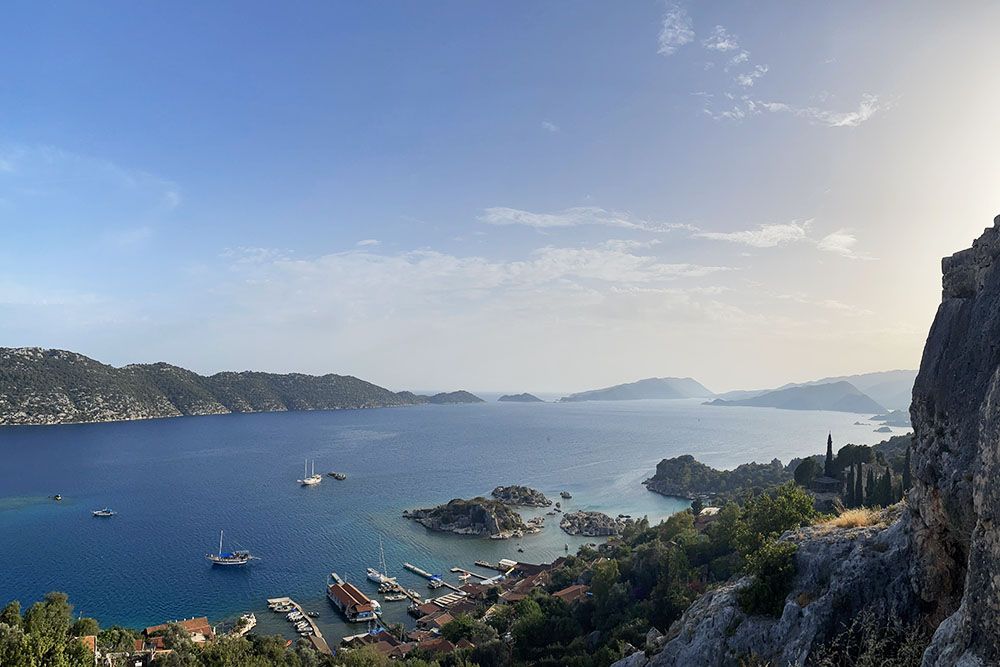
A brief history of Antalya
Antalya is a city with a rich history dating back to antiquity. The area was already inhabited 5,000 years BC, but there was no city yet. This changed around 150 BC. At that time, Attalos II of Pergamon founded the port city of “Attaleia” (as Antalya was then called). Upon his death, his nephew bequeathed his kingdom with the city to the Romans. A period of prosperity followed.
During the Byzantine period, Antalya came under the influence of the Eastern Roman Empire and became an important trade centre. In the 13th century, the Seljuk Empire conquered Antalya, which later became part of the Ottoman Empire. During this period, the city retained its prosperity as a centre of trade and agriculture.
After the fall of the Ottoman Empire, Antalya became part of the modern Turkish Republic and grew into an important tourist destination. Nowadays, Antalya is known for its beautiful beaches, historical sights and vibrant culture that reflect the legacy of its rich history.
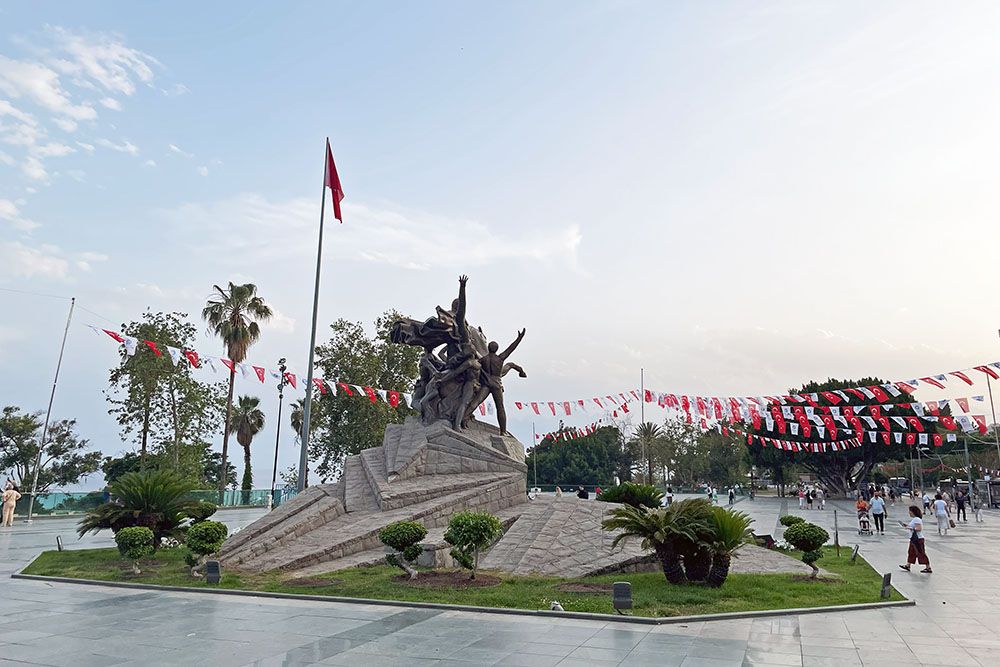
Exploring the interesting city of Antalya
In Antalya, the focus is mainly on history. This is the city of the ancient civilisations, of which much has been preserved. In this blog, we will therefore focus primarily on the historical sights. But of course, we will not overlook the cultural and culinary highlights either.
Hadrian’s Gate
We start our city tour through the old town symbolically at the Gate of Hadrian. This gate was built in 130 AD in honour of Emperor Hadrian. The gate was later part of the city walls around Antalya and is now the only remaining entrance gate. We see three arches in a white marble frame, with elegant columns and rich decorations. On either side of the elegant structure stands a small tower. The southern tower dates from the Roman period. The upper part of the northern tower was rebuilt in the 13th century. Hadrian’s gate is considered the most beautiful in southern Türkiye.
The eight-metre-high gate only came into view in the middle of the last century when the city walls collapsed. In 1959, the gate was restored. Bronze letters were found at the entrance at the time, forming an inscription in honour of Hadrian. The letters are now scattered across various museums.
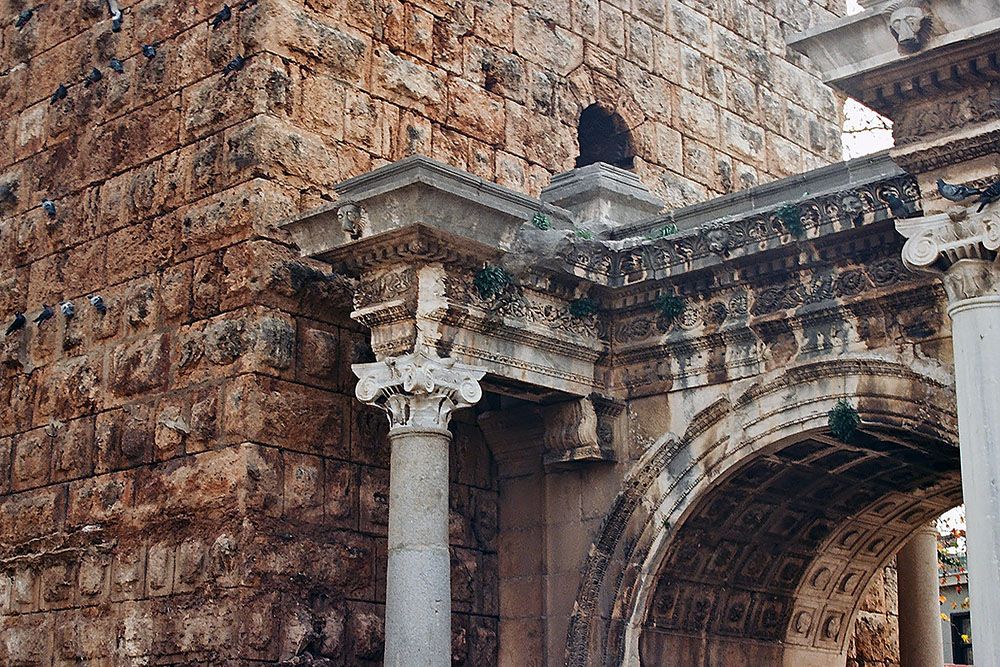
Kaleiçi, the Old Town
We walk under the Gate of Hadrian and emerge into Kaleiçi, the old town centre. Kaleiçi has experienced the Hellenistic, Roman, Byzantine, Seljuk and Ottoman eras. Each era has left an indelible mark on the architecture and character of the old town. Once surrounded by thick stone walls, Kaleiçi served as a strategic port and fortress.
Today, the historic district has been carefully restored and preserved, transforming it into a charming and picturesque destination. As we wander through the narrow, winding streets, we are transported back in time. We realise that over 2,000 years ago, people were already walking where we are now walking. Yet many of the buildings date from the 18th and 19th centuries. Most of the traditional Turkish houses have now been transformed into boutique hotels, restaurants and shops.
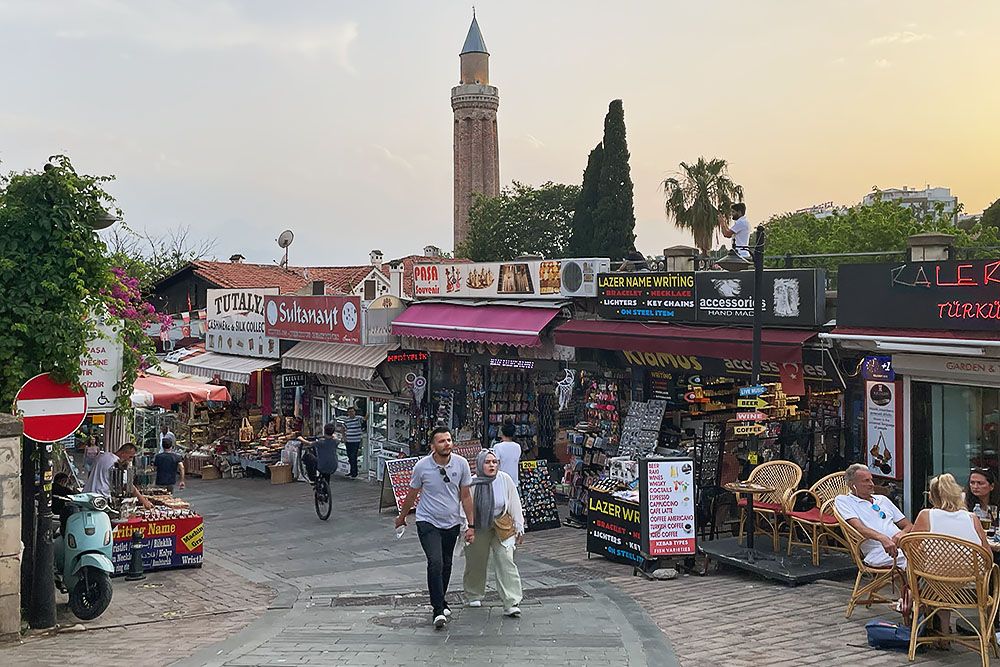
Yivli Minaret Mosque
One of the most recognisable and iconic buildings in the old town is the Yivli Minaret Mosque. This beautiful mosque, also known as the Alaaddin Mosque, is an important part of Antalya’s rich Islamic heritage. The mosque was built in the mid-13th century. The most striking feature is the tall, flanked minaret. With its unique, fluted design and a height of 38 metres, the tower is a true eye-catcher.
In addition to the impressive minaret, the mosque is characterised by its beautiful Seljuk decorations, including carved stones, calligraphy and tile tableaux. The interior is also atmospheric, with a central prayer hall, a mihrab (niche indicating the direction of Mecca) and a mimbar (pulpit). Originally, the mosque was part of a larger complex that also included an Islamic school, a hamam and an inn. Unfortunately, these other buildings have not been preserved.
From the mosque garden, we enjoy the beautiful view over the old town. We then visit the remains of another mosque: the Kesik Minare Mosque.
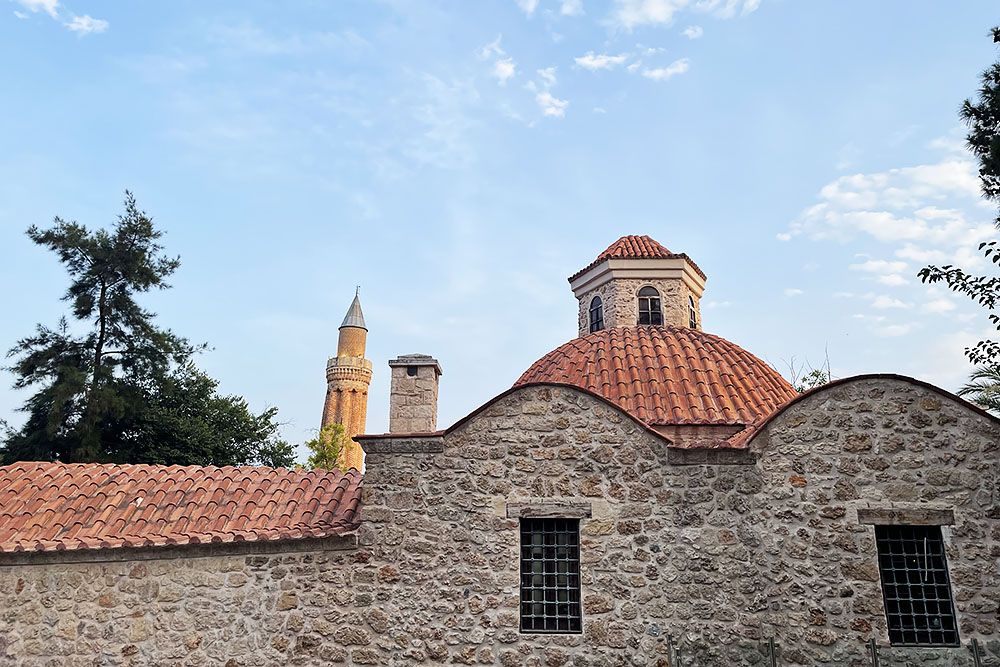
Kesik Minare Mosque
The Kesik Minare Mosque is a silent witness to the cultural and religious changes that this region has undergone. The origin of the location of the place of worship dates back to Roman times, when there was still a temple. In the 7th century, this building was converted into a Byzantine church dedicated to the Virgin Mary. Unfortunately, the church was heavily damaged during the Arab invasions in the same century.
In the 13th century, Antalya fell under the rule of the Seljuk Empire of Rûm. The church was then converted into a mosque with a minaret. But in the mid-14th century, when the Crusaders conquered the city, it became a church again. It was not until the Ottoman period that it definitively became a mosque. In 1800, the main structure of the mosque was destroyed by a large fire, but the minaret survived. This broken minaret, now known as the Kesik Minare, is the only remnant of the original building.
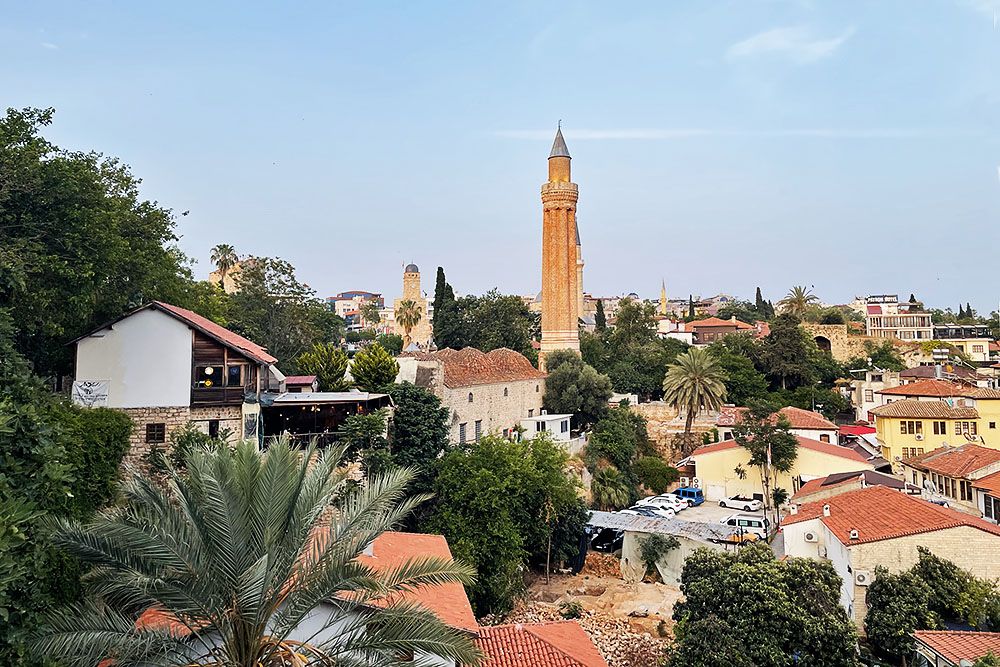
The old harbour
The old harbour of Antalya is a charming and picturesque part of this beautiful Turkish city on the Mediterranean Sea. With a history dating back to the 9th century, the harbour is closely linked to the development of prosperous Antalya.
In the early years, the harbour served as a naval base for Arab conquerors. Under Seljuk rule, the harbour grew into an important hub for trade routes in the region. The harbour brought great prosperity to the city, until it lost its significance in the 15th century. Nowadays, the old harbour is mainly used as a marina and departure point for beautiful boat trips. Around the harbour, there are many cosy cafés, terraces and restaurants.
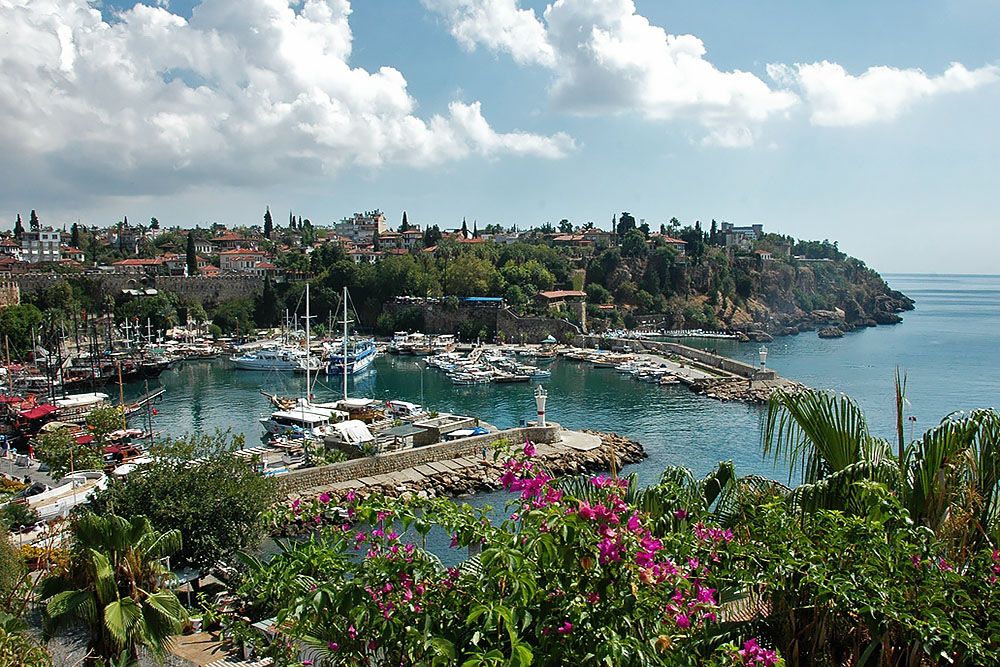
The Antalya Archaeological Museum
Antalya is located in the ancient region of Pamphylia, a region that has known many civilisations. The city therefore has a particularly rich archaeological heritage. To learn more about this, our very knowledgeable and excellent guide Uraz takes us to the Antalya Archaeological Museum. This museum, Uraz tells us, is one of the best and largest in the country.
The 13 exhibition halls and outdoor gallery contain more than 25,000 museum pieces, of which 5,000 are permanently on display. They date from prehistory and from the Greek, Roman, Byzantine and Ottoman periods. But we also come across museum pieces from the rural life of Antalya in the early 20th century. Some highlights of the museum are:
- Natural History Hall, with fossils and animal remains from different geological eras
- Prehistoric Hall, with finds from the Palaeolithic, Mesolithic, Neolithic and Bronze Age
- Hall of the Gods, with impressive Roman sculptures
- Hall of the Emperors, with statues of Roman rulers
- Sarcophagus Hall, with beautifully decorated sarcophagi
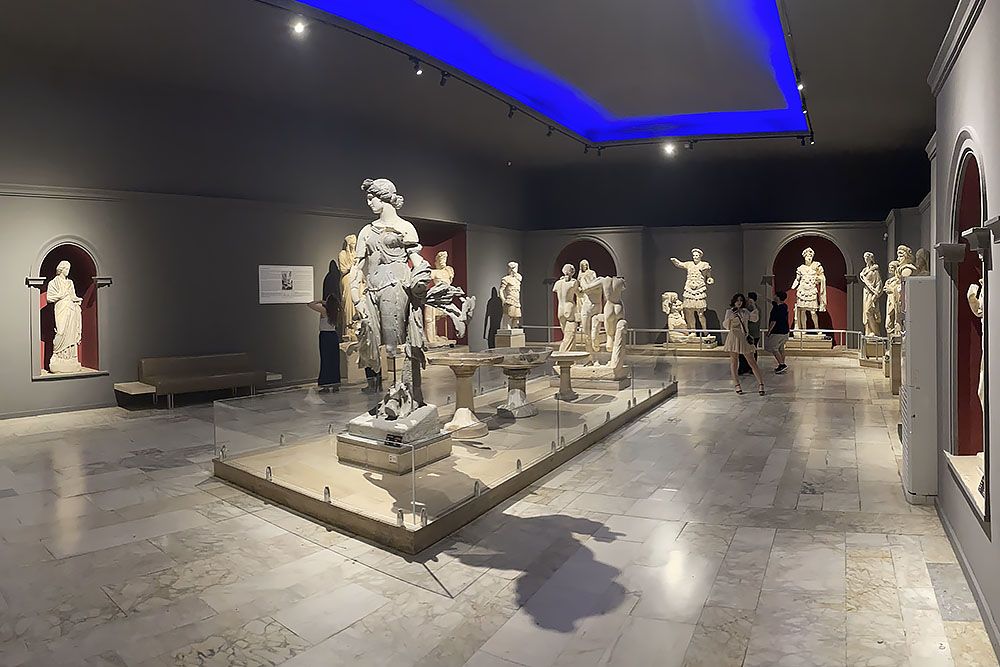
What to see and do in the Antalya region
The Antalya region is an environment where the sea, sun, history and nature harmoniously come together. The 640-kilometre-long coastline along the Mediterranean Sea, surrounded by the Taurus Mountains, offers endless possibilities for beach, history and nature lovers. From the ancient Lycian city of Patara in the west to the beautiful bays of Demre, the diving location of Kaş, the luxury resorts in Kemer and the historic city of Perge: the Antalya region has something for everyone.
The beaches around Antalya
It is no coincidence that Antalya is best known among tourists for its beautiful beaches. The region boasts no less than 231 beaches with the Blue Flag certification (an environmental label). Some of the most popular beaches in the region are Konyaaltı, Lara, Kaputaş and Patara. Patara, located at the westernmost point of the province, in particular, has stunning beaches. This coastal town is also the birthplace of St. Nicholas! But Kaputaş, with its famous clear turquoise sea, is also known as one of the most beautiful beaches in Europe. To reach the latter beach, you have to descend a long staircase (and climb back up on the return journey). The view from the top of the hill is truly breathtaking!
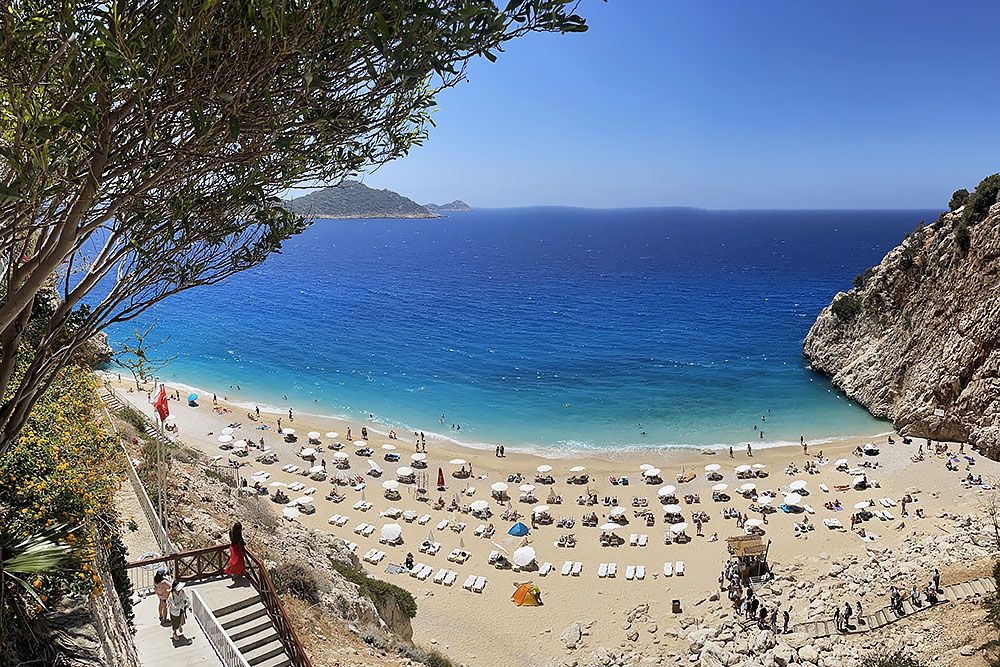
The Numerous Outdoor Opportunities around Antalya
In addition to the beautiful beaches, the Antalya region is also an outdoor paradise. You can explore the Karain, Dim and Damlataş caves, go rafting, ziplining, rock climbing, mountain biking, paragliding, diving and cycling. In addition, you’ll find countless fantastic golf courses in the area. During our tour, we have participated in some of these activities. In our blog about the unprecedented outdoor opportunities in the province of Antalya, we discuss this in more detail.
What particularly appeals to us as avid hikers are the incredible hiking opportunities. You have the famous Lycian Trail, the Pisidia Heritage Trail and the St. Paul’s Trail here. During the tour, we walk some sections of the Lycian Trail: Türkiye’s first long-distance hiking trail. The trail is approximately 500 kilometres long and runs from Fethiye to Antalya. The path crosses the former Lycian peninsula, which was inhabited by the Lycian civilisation. It was one of the most important ancient civilisations in Anatolia (present-day Türkiye).
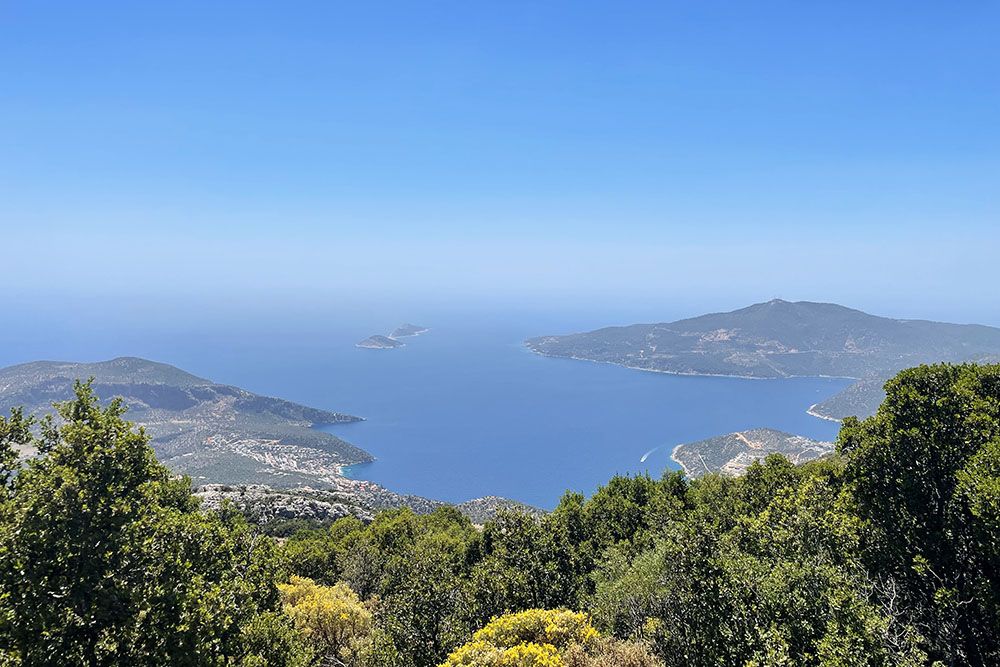
Historical sights in the Antalya region
It becomes clear very quickly that the Antalya region has a particularly rich historical heritage as we leave the city. We visit several ancient ruin cities and are amazed one after the other. Our previous city walks through Rome had made a huge impression on us at the time. The historical sites we are now seeing are in no way inferior to those. But where in Rome we could sometimes walk over the heads of people on some sites, the historical sights here lie abandoned. In one case, we are even the only ones admiring the ruins of an ancient city.
We published a separate blog on this site about our historical exploration in this part of Türkiye. In this blog we describe our visit to various ancient cities. We also visit Patara and Myra where we witness an Eastern Orthodox church service in the old church of St. Nicholas.
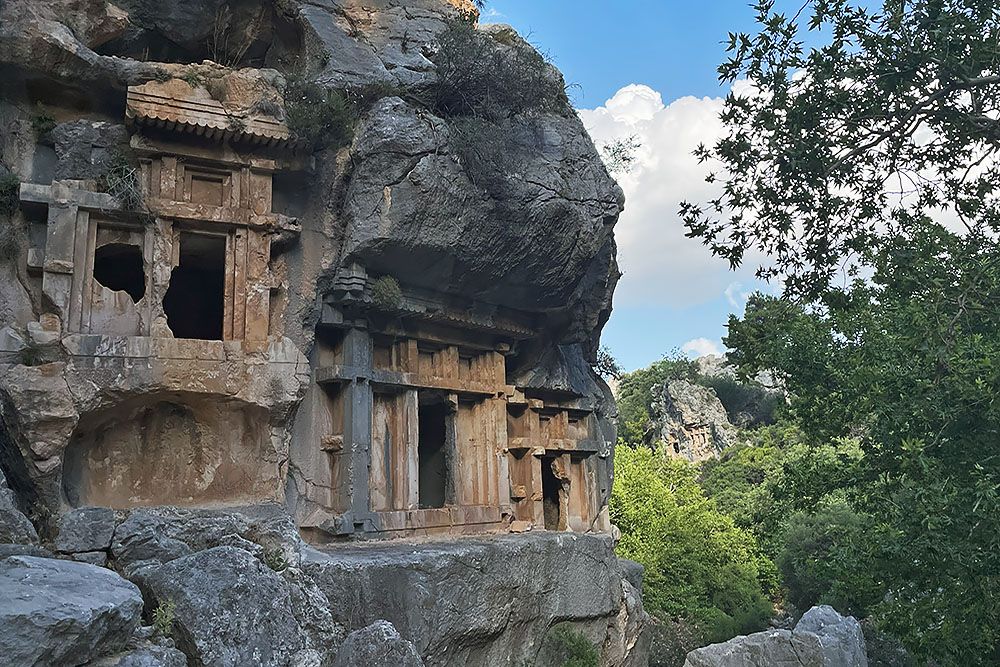
Practical matters for your stay in Antalya
The best time for a city trip to Antalya is in spring and autumn. The summers are hot with stuffy nights. The winters are usually mild, but it can rain and storm a lot then.
In Kaleici, the old town, the bicycle or your own two feet are your only means of transport. If you also want to explore the area outside the old town centre, take the tram, bus or taxi. Or rent a car! Driving around with a rental car is doable and certainly not expensive.
Take the Antalyakart if you plan to use public transport. Do you also want to visit various interesting attractions? Then take the Antalya City Pass. In addition to public transport, the city pass includes several interesting attractions.
Here are the main sights in Antalya that you shouldn't miss:
- The Gate of Hadrian: An impressive triumphal arch from 130 AD, built in honour of Emperor Hadrian. The elegant structure is one of Antalya's most famous landmarks. The gate was once part of the city walls, but only came back into view in the 20th century after the collapse of the walls.
- Kaleiçi: The historic centre of Antalya. This old town bears the traces of various civilisations - Hellenistic, Roman, Byzantine, Seljuk and Ottoman. The narrow, winding streets with traditional Turkish houses, now transformed into hotels and shops, take you back in time.
- Yivli Minaret Mosque: An icon of Antalya, with its unique, fluted 38-metre-high minaret from the 13th century. The interior is also beautiful, with Seljuk decorations.
- Kesik Minare Mosque: A remnant of a Byzantine church, later converted into a mosque. The broken minaret is the only remaining part of the original building.
- The old harbour of Antalya. This harbour has a rich history, from an Arab naval base to an important trade centre under the Seljuks. Nowadays, it is a charming marina and departure point for boat trips.
- Archaeological Museum: One of the best historical museums in Türkiye, with more than 25,000 museum pieces from prehistory to the Ottoman period, testifying to the rich history of this region.
The Antalya region is an environment of sun, sea, history and nature. The 640-kilometre-long coastline along the Mediterranean Sea, surrounded by the Taurus Mountains, offers endless possibilities for beach, history, nature and outdoor enthusiasts. From the ancient Lycian city of Patara in the west to the beautiful bays of Demre, the diving location of Kaş, the luxury resorts in Kemer, the many golf courses near Belek and the historic city of Perge: the Antalya region has something for everyone.
The Antalya area also offers fantastic hiking opportunities. You have the famous Lycian Trail, Türkiye's first long-distance hiking trail. The trail is approximately 500 kilometres long and runs from Fethiye to Antalya. The path crosses the former Lycian peninsula.
Antalya's fertile lands and rich culture have greatly influenced the local cuisine of today. Some specialities of the region:
- Finike orange: Antalya's most famous citrus fruit. The fruit is juicy, sweet and rich in vitamins.
- Jam: Traditionally handmade jam, often based on citrus fruits, is an important part of the gastronomy.
- Antalya Piyazı: A traditional bean dish with tarator sauce, unique to Antalya and the surrounding area.
- Yörük Kebab: A meat dish with lots of vegetables and spices, inspired by the nomadic Yörük culture in the Taurus Mountains.
- Yanıksı Dondurma: Refreshing ice cream based on goat's milk from the mountains, without additives.
- Antalya Köfte: Unique meatballs, seasoned only with salt, grilled on a spit.
- White sea bream: A typical Mediterranean fish, cooked in salt for a unique flavour.
Apart from the many luxury resorts on the coast, the best accommodations in Antalya are mainly located in the historic city centre of Kaleiçi. Here you'll find many traditional and boutique hotels. We mention the accommodations with generally (very) good reviews:
- RuinAdalia - A charming boutique hotel in a prime location right in the old town. The underground archaeological site literally under the hotel is very special. We stayed here ourselves.
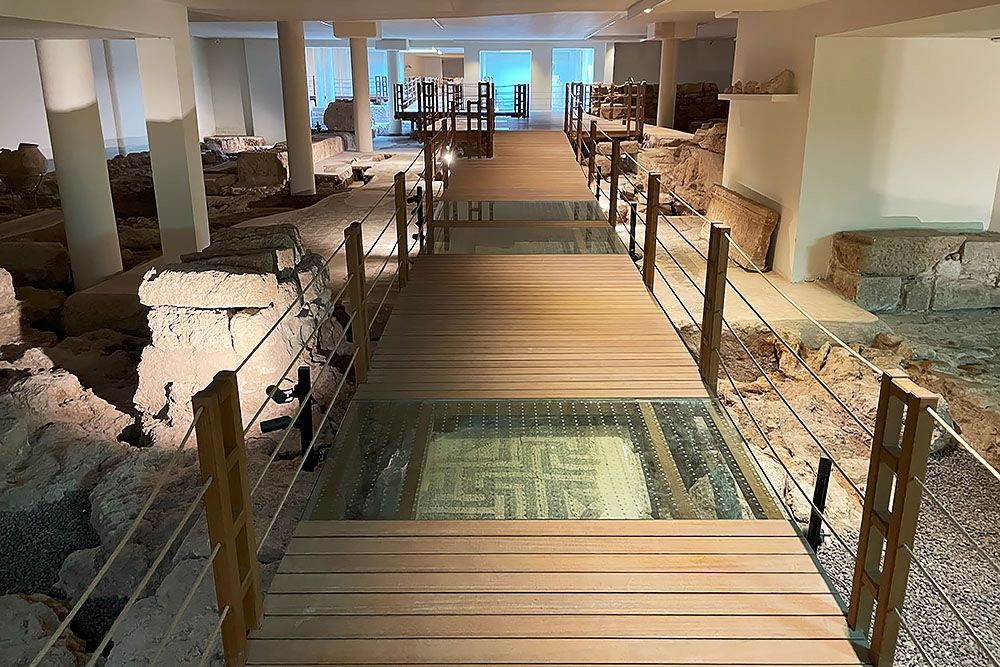
- Tekeli Konaklari - A former residence of an Ottoman pasha with elegant traditional Turkish houses around a patio.
- Hotel 1207 - Charming traditional guesthouse in the heart of the old town, with a courtyard garden and pool.
- Hotel Lykia - Magnificent and very atmospheric boutique hotel near the Gate of Hadrian.
- Dogan Hotel - Ottoman-style hotel in a quiet corner of the historic city centre, with local cuisine.
- Tuvana Hotel - Historic city palace in a green garden, with a pool and excellent restaurant.
Check the overview of other accommodations in Antalya.
We visited Antalya at the invitation of Go Türkiye. This visit was part of a tour along the Mediterranean coast of Türkiye. We have compiled the content of this blog independently and objectively based on our own impressions.
